Optogenetics Market Size
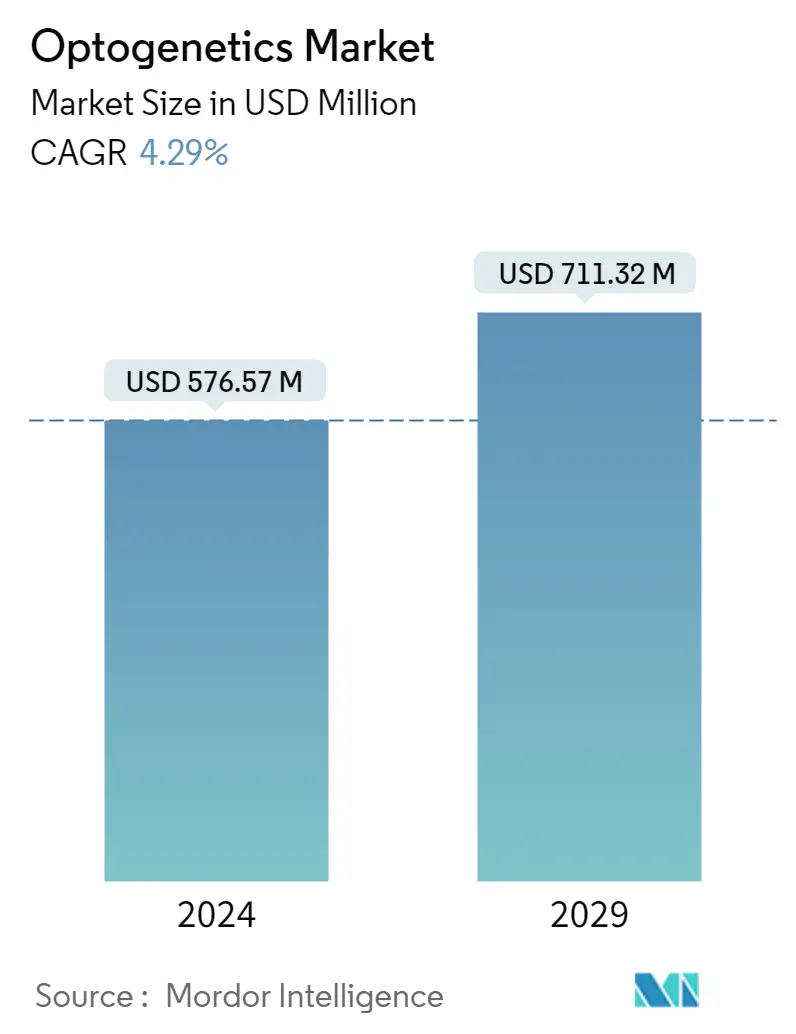
| Study Period | 2019 - 2029 |
| Market Size (2024) | USD 576.57 Million |
| Market Size (2029) | USD 711.32 Million |
| CAGR (2024 - 2029) | 4.29 % |
| Fastest Growing Market | Asia Pacific |
| Largest Market | North America |
Major Players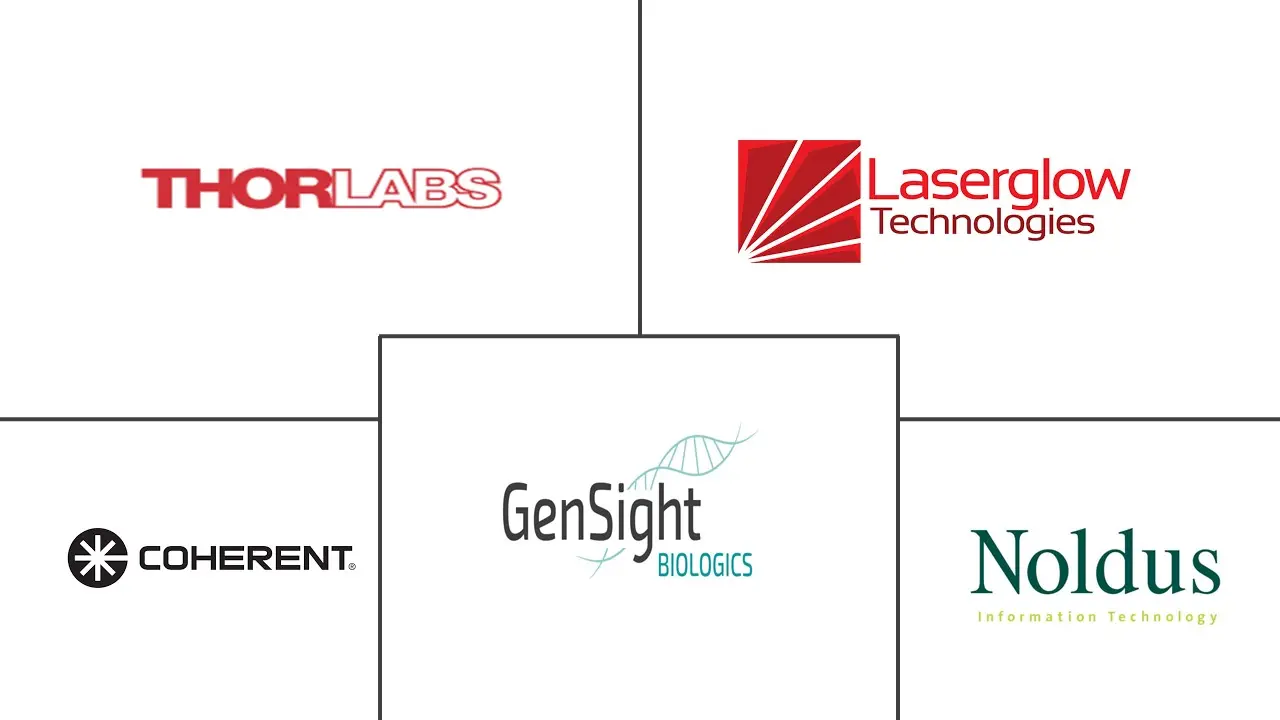
*Disclaimer: Major Players sorted in no particular order |
Optogenetics Market Analysis
The Optogenetics Market size is estimated at USD 576.57 million in 2024, and is expected to reach USD 711.32 million by 2029, growing at a CAGR of 4.29% during the forecast period (2024-2029).
The COVID-19 pandemic is expected to impact the optogenetics market significantly. According to the article published by PUS University in February 2022 by Shanet Suzan Alex, SARS-CoV-2 causes neurological abnormalities and respiratory symptoms, with an 85% occurrence rate in Alzheimer's patients. As per the same source, SARS-CoV-2 infiltrated COVID-19 patients' cognitive centers, causing Alzheimer's-like phenotypes in those with no underlying conditions and exacerbating Alzheimer's neuropathology in those with Alzheimer's and autism. As a result, COVID-19 had many complications in patients with neurological disorders, and the market was significantly impacted. However, as the pandemic has currently subsided, neurology care has gone back to pre-pandemic levels, which are expected to increase the adoption of optogenetic products and lead to a normal market growth over the forecast period.
The major factors driving the market's growth include the scope of optogenetics as a potential diagnostic tool in neurosciences, the rapid growth of advanced technologies, and the increasing use of multimodal imaging. Optogenetics technology has revolutionized neuroscience in the last few years by allowing researchers to control specific neurons in experimental animals. The ability to control neurons has revealed information about brain pathways involved in diseases such as depression, obsessive-compulsive disorders, Parkinson's disease, and other conditions. In neural research, optogenetic methods for monitoring synaptic activity have proven to be extremely useful in several neurological diseases.
It allows researchers to study how the neurological activity patterns within specific brain cells give rise to thoughts, behaviors, and memories at unprecedented precision. Thus, it helps find cures and treatments for neurological and psychiatric disorders like depression, addiction, schizophrenia, and Parkinson's disease. For instance, according to the article published by Frontiers in April 2022, Parkinson's disease is said to be a chronic disease with no clinical cure. However, it can be alleviated and treated with optogenetics. Thus, the use of optogenetics in the treatment of Parkinson's proved a potent tool used to treat neurological diseases.
Also, rising cases of neurological disorders such as Parkinson's, Alzheimer's, epilepsy, and Huntington's disease may boost the market. According to an article published by scientific reports in October 2022, Parkinson's disease (PD) is often associated with dementia, and dementia causes a substantial negative impact on the affected individual, their care partners, and society. The affected individual loses their ability to function independently and faces a reduced survival and health-related quality of life. The article also reported that the cumulative prevalence of Parkinson's disease in the last 10 years in Sweden was 54%. Thus, the high burden of Parkinson's disease is expected to boost the usage of optogenetics.
The rising developments by major players are also expected to boost the market's growth. For instance, in September 2021, TSE Systems, one of the leaders in advanced preclinical research equipment for metabolic and behavioral research, and NeuroLux, the developer of battery-free wireless optogenetics implants for preclinical research, announced an exclusive partnership.
Hence, factors such as the increasing use of optogenetics for the treatment of neurological disorders, the rising prevalence of neurological diseases, and the increasing developments by key players are expected to boost the market's growth. However, a lack of awareness and the high costs of technology may restrain this growth over the forecast period.
Optogenetics Market Trends
Light-emitting Diode (LED) Segment is Expected to Hold a Significant Share in the Optogenetics Market
Light-emitting diodes (LED) surpass lasers in every aspect, as they are cheaper, smaller, more reliable, and easier to control. They are being incorporated into implants, allowing untethered light delivery. Factors such as investment in technology, product launches, and research studies in the segment are expected to drive the segment's growth.
For instance, according to a study published by Frontiers in January 2022, a near-infrared ultrafast laser micro irradiation platform can be used to deliver gene encoding for neuroprotective and anti-angiogenic pigment epithelium-derived factor (PEDF) molecules to the retina, which exhibits protection from different insults. The research studies expanding the scope of light-emitting diode (LED) may also contribute to the market's growth.
The rising prevalence of neurological disorders is also expected to boost segment growth. For instance, according to an article published by the lancet regional health in April 2022, a study was conducted in Latin America and the Caribbean countries, including Argentina, showing a moderately high pooled prevalence of idiopathic epilepsy in Argentina.
The rising number of clinical trials is also expected to boost segment growth. For instance, in January 2021, SYMBXX initiated two clinical trials in Adelaide, Australia, and Toronto, Canada, to develop laser light therapies to reduce the debilitating symptoms of Parkinson's disease. The clinical trials focused on seeking regulatory approvals may drive the market during the forecast period. The increasing research spending on neuroscience is also expected to boost the adoption of light-emitting diodes (LED).
Therefore, factors such as the rising number of clinical trials, the rising prevalence of neurological disorders, and the increasing R&D in neurological diseases are anticipated to boost the segment's growth during the forecast period.
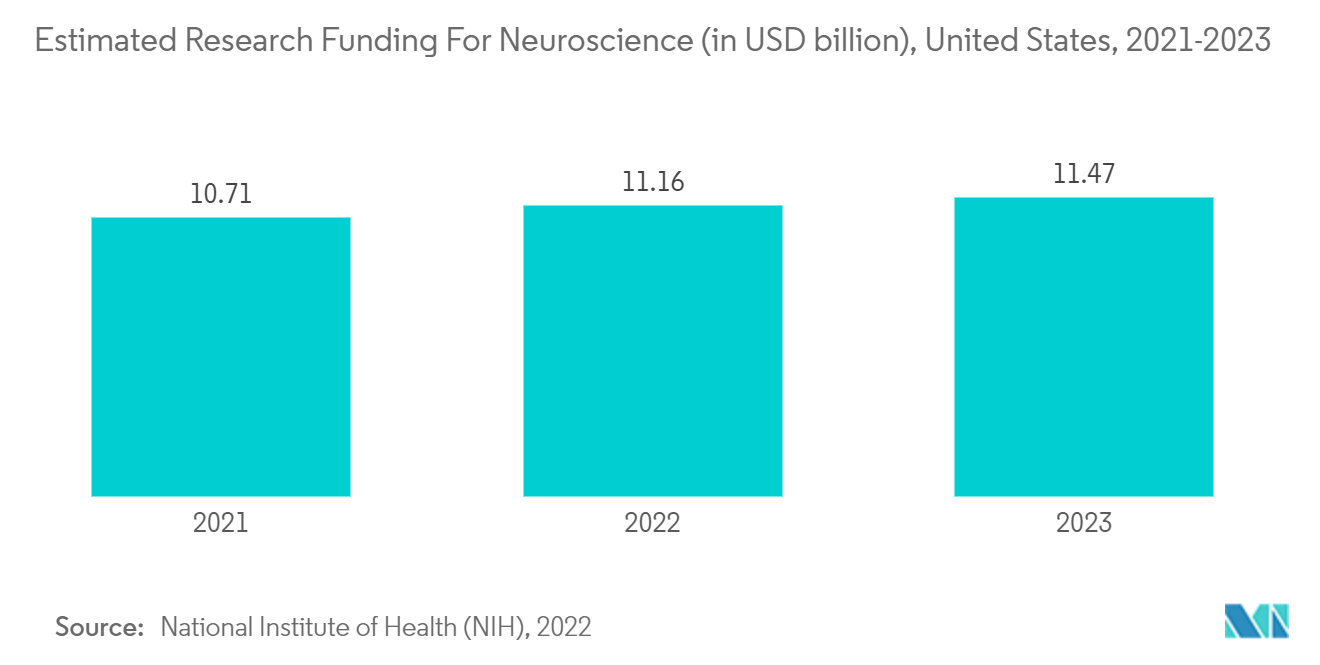
North America is Expected to Hold a Significant Market Share Over the Forecast Period
North America is expected to lead the market due to the increasing use of optogenetic devices, primarily in academic and research labs, the high burden of chronic diseases in the region, and the collaborations and new product launches by key market players.
Increasing government initiatives in the neurological field are the key growth factors. Increasing funding allows multiple players to enter the market and provide innovative solutions to cater to patient needs. For instance, as per the National Center for Chronic Disease Prevention and Health Promotion in January 2021, 6 in 10 adults in the United States have a chronic disease, and 4 in 10 adults have two or more chronic diseases. These conditions cost USD 3.8 trillion to the country's healthcare system every year, which may significantly impact the growth of the studied market.
The rising prevalence of neurological diseases is also expected to boost the North American market. For instance, according to the report published by the Alzheimer Society of Canada in September 2022, by 2050, more than 1.1 million Canadians will have Alzheimer's dementia, making it the most common type of dementia overall. In addition, in December 2021, the University of British Columbia stated that more than 500,000 Canadians have Alzheimer's or similar dementia. By 2031, it is anticipated that the number will have doubled due to the growing aging population. This shows the high burden of the disease, which is expected to increase the demand for optogenetics products.
The increasing patient population requires more care, increasing the demand for optogenetics and boosting the market's growth. Collaborations and agreements are also anticipated to drive the market. For instance, in September 2021, NeuroLux Inc. announced its exclusive partnership with TSE Systems to integrate its wireless technology with TSE System's IntelliCage and PhenoMaster platforms, providing optogenetic, pharmacology, telemetry, and other capabilities for cutting-edge behavioral neuroscience research. Such collaborations increase innovation due to the synchronization of key players' resources, thus boosting the market.
Similarly, in June 2021, Nanoscope Therapeutics Inc., a clinical-stage biotechnology company that is developing gene therapies for the treatment of retinal diseases, announced that vision improvements for all evaluated advanced retinitis pigmentosa (RP) patients persisted for one year following a single intravitreal injection in a Phase 1/2a clinical study with Multi-Characteristic Opsin (MCO) to retinal cells. Such studies improve the advantages of optogenetics.
Hence, factors such as the rising investment in neurological disease research and the increasing prevalence of neurological disorders are likely to boost the market's growth in the region.
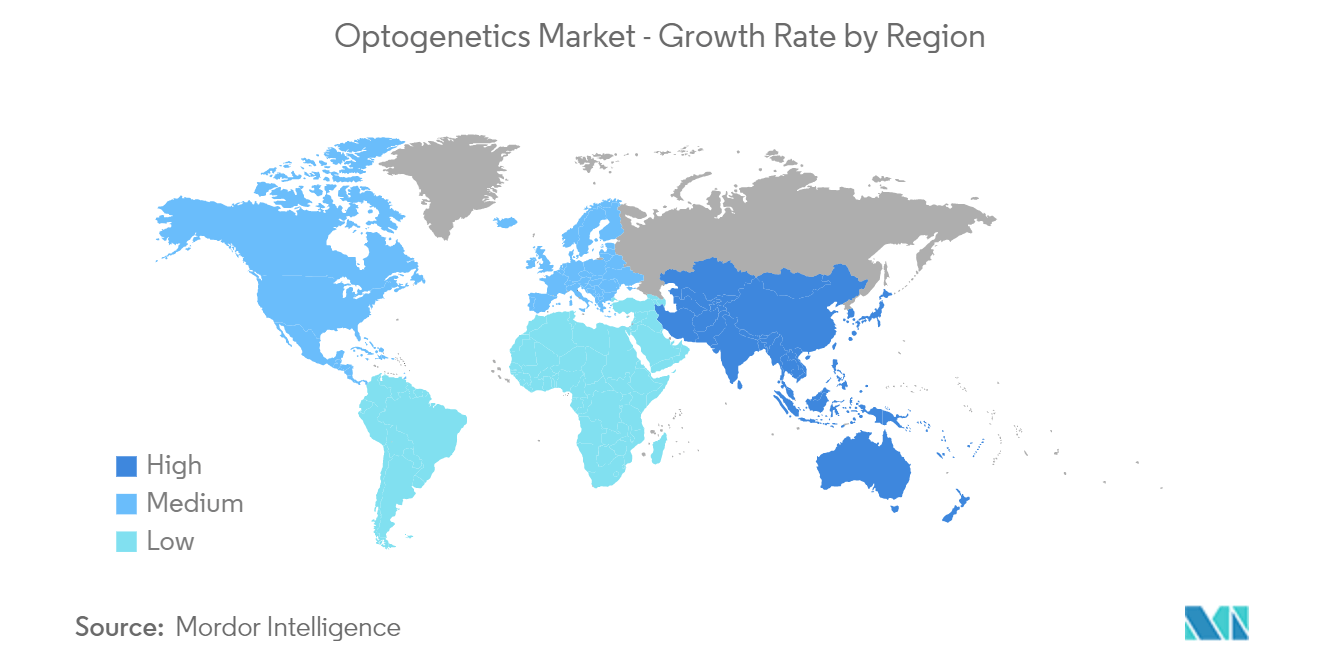
Optogenetics Industry Overview
The optogenetics market is moderately consolidated due to the presence of various small and large players. In terms of market share, a few of the major players are currently dominating the market. Most of these companies are involved in strategies such as investing in R&D, acquisitions, and collaborations. Some players include Hubner Group (Cobolt Inc.), Coherent Inc., Gensight Biologics, Laserglow Technologies, Noldus Information Technology, Shanghai Laser & Optics Century Co. Ltd, and Thorlabs Inc.
Optogenetics Market Leaders
-
Laserglow Technologies
-
Coherent Inc.
-
Thorlabs Inc.
-
Gensight Biologics
-
Noldus Information Technology
*Disclaimer: Major Players sorted in no particular order
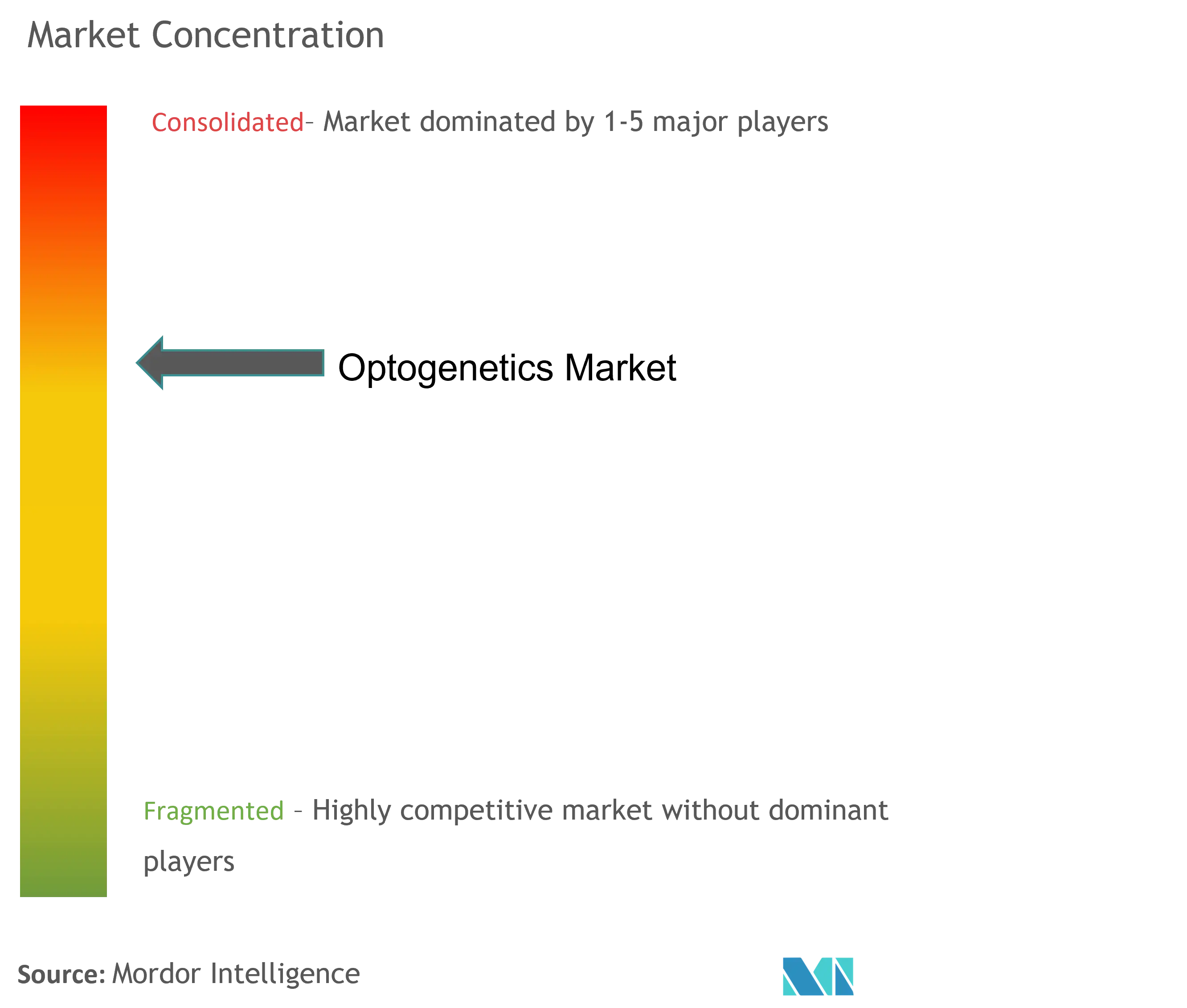
Optogenetics Market News
- In February 2023, GenSight Biologics announced the 1 Year safety data and efficacy signals from the PIONEER phase I/II clinical trial of GS030, an optogenetic treatment candidate for retinitis pigmentosa.
- In June 2022, Bruker Corporation launched the NeuraLight 3D Ultra module to support advanced neuroscience and optogenetics research applications on Bruker's Ultima multiphoton microscopes.
Optogenetics Market Report - Table of Contents
1. INTRODUCTION
- 1.1 Study Assumptions and Market Definition
- 1.2 Scope of the Study
2. RESEARCH METHODOLOGY
3. EXECUTIVE SUMMARY
4. MARKET DYNAMICS
-
4.1 Market Drivers
- 4.1.1 Potential Diagnostic Tool in the Field of Neurosciences
- 4.1.2 Rapid Growth of Advanced Technology
- 4.1.3 Increasing Use of Multimodal Imaging
-
4.2 Market Restraints
- 4.2.1 High Cost of Technology
- 4.2.2 Lack of Awareness
-
4.3 Porter's Five Forces Analysis
- 4.3.1 Threat of New Entrants
- 4.3.2 Bargaining Power of Buyers/Consumers
- 4.3.3 Bargaining Power of Suppliers
- 4.3.4 Threat of Substitute Products
- 4.3.5 Intensity of Competitive Rivalry
5. MARKET SEGMENTATION (Market Size by Value - USD million)
-
5.1 By Light Equipment
- 5.1.1 Laser
- 5.1.2 Light-emitting Diode (LED)
-
5.2 By Actuator
- 5.2.1 Channelrhodopsin
- 5.2.2 Halorhodopsin
- 5.2.3 Archaerhodopsin
-
5.3 By Sensor
- 5.3.1 Calcium (Aequorin, Cameleon, and Other Calcium Sensors)
- 5.3.2 Chloride (Clomeleon)
- 5.3.3 Membrane-gated (Mermaid)
- 5.3.4 Other Sensors
-
5.4 By Application
- 5.4.1 Neuroscience
- 5.4.2 Behavioral Tracking
- 5.4.3 Retinal Disease Treatment
- 5.4.4 Other Applications
-
5.5 By Geography
- 5.5.1 North America
- 5.5.1.1 United States
- 5.5.1.2 Canada
- 5.5.1.3 Mexico
- 5.5.2 Europe
- 5.5.2.1 Germany
- 5.5.2.2 United Kingdom
- 5.5.2.3 France
- 5.5.2.4 Italy
- 5.5.2.5 Spain
- 5.5.2.6 Rest of Europe
- 5.5.3 Asia-Pacific
- 5.5.3.1 China
- 5.5.3.2 Japan
- 5.5.3.3 India
- 5.5.3.4 Australia
- 5.5.3.5 South Korea
- 5.5.3.6 Rest of Asia-Pacific
- 5.5.4 Middle East and Africa
- 5.5.4.1 GCC
- 5.5.4.2 South Africa
- 5.5.4.3 Rest of Middle East and Africa
- 5.5.5 South America
- 5.5.5.1 Brazil
- 5.5.5.2 Argentina
- 5.5.5.3 Rest of South America
6. COMPETITIVE LANDSCAPE
-
6.1 Company Profiles
- 6.1.1 Hubner Group (Cobolt Inc.)
- 6.1.2 Coherent Inc.
- 6.1.3 Gensight Biologics
- 6.1.4 Laserglow Technologies
- 6.1.5 Noldus Information Technology
- 6.1.6 Judges Scientific PLC (Scientifica)
- 6.1.7 Shanghai Laser & Optics Century Co. Ltd
- 6.1.8 Bruker Corporation
- 6.1.9 Thorlabs Inc.
- *List Not Exhaustive
7. MARKET OPPORTUNITIES AND FUTURE TRENDS
** Subject To AvailablityOptogenetics Industry Segmentation
As per the report's scope, optogenetics refers to a range of optical techniques used to elicit a physiological response in targeted biological systems without pharmacology and electric stimulations. Optogenetics controls neural activity by combining genetic engineering and optical tools. It is widely used in neuroscience for the modulation of neural circuits with high precision and specificity.
The optogenetics market is segmented by light equipment (laser and light-emitting diode), actuator (channelrhodopsin, halorhodopsin, and archaerhodopsin), sensor (calcium (aequorin, cameleon, and other calcium sensors), chloride (clomeleon), membrane-gated (mermaid), and other sensors), application (neuroscience, behavioral tracking, retinal, disease treatment, and other applications), and geography (North America, Europe, Asia-Pacific, Middle East and Africa, and South America). The report also covers the estimated market sizes and trends for 17 countries globally. The report offers the value (USD million) for the above segments.
| By Light Equipment | Laser | |
| Light-emitting Diode (LED) | ||
| By Actuator | Channelrhodopsin | |
| Halorhodopsin | ||
| Archaerhodopsin | ||
| By Sensor | Calcium (Aequorin, Cameleon, and Other Calcium Sensors) | |
| Chloride (Clomeleon) | ||
| Membrane-gated (Mermaid) | ||
| Other Sensors | ||
| By Application | Neuroscience | |
| Behavioral Tracking | ||
| Retinal Disease Treatment | ||
| Other Applications | ||
| By Geography | North America | United States |
| Canada | ||
| Mexico | ||
| By Geography | Europe | Germany |
| United Kingdom | ||
| France | ||
| Italy | ||
| Spain | ||
| Rest of Europe | ||
| By Geography | Asia-Pacific | China |
| Japan | ||
| India | ||
| Australia | ||
| South Korea | ||
| Rest of Asia-Pacific | ||
| By Geography | Middle East and Africa | GCC |
| South Africa | ||
| Rest of Middle East and Africa | ||
| By Geography | South America | Brazil |
| Argentina | ||
| Rest of South America |
Optogenetics Market Research FAQs
How big is the Optogenetics Market?
The Optogenetics Market size is expected to reach USD 576.57 million in 2024 and grow at a CAGR of 4.29% to reach USD 711.32 million by 2029.
What is the current Optogenetics Market size?
In 2024, the Optogenetics Market size is expected to reach USD 576.57 million.
Who are the key players in Optogenetics Market?
Laserglow Technologies, Coherent Inc., Thorlabs Inc., Gensight Biologics and Noldus Information Technology are the major companies operating in the Optogenetics Market.
Which is the fastest growing region in Optogenetics Market?
Asia Pacific is estimated to grow at the highest CAGR over the forecast period (2024-2029).
Which region has the biggest share in Optogenetics Market?
In 2024, the North America accounts for the largest market share in Optogenetics Market.
What years does this Optogenetics Market cover, and what was the market size in 2023?
In 2023, the Optogenetics Market size was estimated at USD 552.85 million. The report covers the Optogenetics Market historical market size for years: 2019, 2020, 2021, 2022 and 2023. The report also forecasts the Optogenetics Market size for years: 2024, 2025, 2026, 2027, 2028 and 2029.
Optogenetic Industry Report
Statistics for the 2024 Optogenetic market share, size and revenue growth rate, created by Mordor Intelligence™ Industry Reports. Optogenetic analysis includes a market forecast outlook to 2029 and historical overview. Get a sample of this industry analysis as a free report PDF download.



